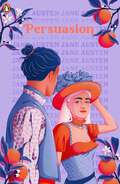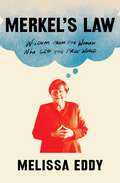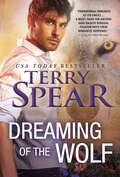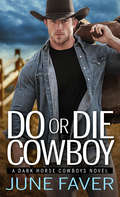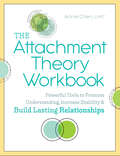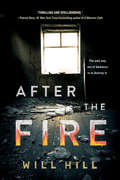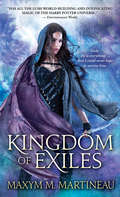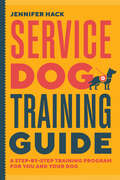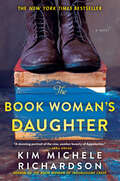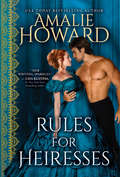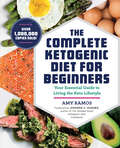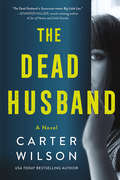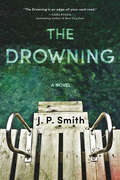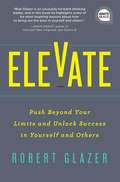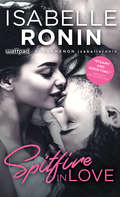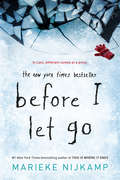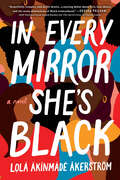- Table View
- List View
Persuasion (First Impressions)
by Jane AustenWith a foreword by Alexis Hall, author of Boyfriend Material and A Lady for a DukeAnne and Captain Wentworth fell in love eight years ago. Although Anne broke off their engagement as her father wished, their flame flickers on, however dim.When they finally meet again, Wentworth has secured wealth and status to become an eligible option. But both Anne and Wentworth have their eyes on other people, and Anne must follow her heart to decide whether to start again or rekindle an old flame.Fall head over heels for First Impressions, Penguin's boldly designed new Jane Austen collection for young-adult readers featuring the complete and unabridged texts. Full of meet-cutes, missed connections and drama, this eye-catching six-book series is an open invitation to embrace your inner romantic
Merkel's Law: Wisdom from the Woman Who Led the Free World
by Melissa EddyIn the vein of Notorious RBG, a fun and inspiring biography filled with lessons from the most powerful woman in the world, based on more than a decade&’s worth of coverage of German Chancellor Angela Merkel from New York Times Berlin correspondent Melissa Eddy.Angela Merkel is a boss. A trailblazer. An icon of colorful suits. Formerly the new leader of the free world. With an entire hand gesture named after her (the &“Merkel Diamond&”) and celebrated in a viral meme for sparring with Trump, Angela Merkel spent a decade economically and politically revitalizing her country. The first woman chancellor of Germany and one of the longest-serving European leaders ever, Merkel&’s quiet resolve, calculated confidence, and extreme privacy around her personal life have made her a feminist role model for the ages. Merkel&’s Law is a revelatory look at an unlikely vanguard, and at the country she led for sixteen years. No one is better positioned than New York Times Berlin correspondent Melissa Eddy to pull back the curtain on the woman who engineered Germany&’s rise to wealth, power, and an economy worth 3.8 trillion in USD. Drawing upon an unparalleled well of sources close to Merkel, Merkel&’s Law traces her childhood in East Germany as the daughter of a clergyman, her meteoric rise to power, and her more recent public acclaim—as well as the numerous setbacks she faced along the way both from political rivals and from men in her own party who scoffed at her ambition. Painting a portrait of a political genius, savvy businesswoman, and model for modern power, Merkel&’s Law is not only the story of her life, but the lessons we can learn from it.
The Complete Anti-Inflammatory Diet for Beginners: A No-Stress Meal Plan with Easy Recipes to Heal the Immune System
by Dorothy Calimeris Lulu Cook RDNThe no-stress guide to boosting energy and relieving pain with the anti-inflammatory diet It's possible to reverse chronic inflammation and improve overall health through simple dietary changes, and The Complete Anti-Inflammatory Diet for Beginners breaks the process down into simple, actionable steps that anyone can take—starting today.With easy recipes and weekly shopping lists, this essential anti-inflammatory diet cookbook makes it easy for you to start and follow an anti-inflammatory diet that can help you strengthen your immune system, relieve pain, ease healing, and feel more satisfied and energized every day!Learn the basics of an anti-inflammatory diet—Find guidelines from a registered dietician, including an anti-inflammatory foods list that covers which foods can soothe inflammation and which ones to avoid.Easy meal prep and planning—A 2-week meal plan takes you through exactly what to cook and eat for every meal as you get started, so there's no stress or guesswork.Quick and tasty cooking—Beyond the meal plan, you'll find plenty of healthy recipes to try, most of which only require about 5 main ingredients—from roast chicken with a side of white beans to a hearty lentil and beet salad.Eat and live better with The Complete Anti-Inflammatory Diet for Beginners.
Dreaming of the Wolf (Silver Town Wolf #3)
by Terry SpearA hot paranormal shifter romance full of action, adventure, mystery, and passion from USA Today bestselling author Terry Spear. Perfect for readers of Christine Feehan, Patricia Briggs, and Nalini Singh:Jake Silver has gotten himself into some trouble, and to appease the Silver Town pack leaders, he needs the money he can make selling his photography to local art galleries. When he spies a woman in town sneaking around and taking surreptitious photographs, his intrigue turns into wolfish protectiveness…Alicia Greiston is in a rut. She's determined to turn the town's notorious mobsters over to the police. This kind of work comes with a price—and not just the bounty money. But Jake is just too persuasive to stay away from, and against both their better judgments, she allows herself to be swept under his spell. He's sexy, alpha, and totally irresistible...Praise for the Silver Town Wolf series:"Sensual, passionate and very well written… Terry Spear's writing is pure entertainment."—The Long and Short of It Reviews for Wolf Fever"With non-stop action, thrilling suspense, danger, a beautiful setting, well-drawn characters, this story will keep readers guessing right up to the very satisfying ending."—Romance Junkies for Silence of the Wolf"Terry Spear weaves paranormal, suspense, and romance together in one non-stop rollercoaster of passion and adventure."—Love Romance Passion for Destiny of the Wolf
Do or Die Cowboy (Dark Horse Cowboys #1)
by June FaverTake the suspense and action of B.J. Daniels's Montana Justice series, add the loyal cowboys of Joanne Kennedy's Cowboys of Decker Ranch, mix with June Faver's authentic voice and genuine family dynamics, and you won't be able to put this one down!Cowboy musician Tyler Garrett has a once-in-a-lifetime chance to put aside his rough-and-tumble rancher's lifestyle and realize his dream. There's no room to add love in the mix. He's on the road to Dallas to record a demo when that dream gets kicked sideways by a beautiful woman on the run.Leah Benson will do whatever it takes to keep her daughter safe. But when her dangerous past catches up with her, she needs more than one night with a cowboy—she needs a hero. Good thing Tyler Garrett was born and bred for the role, and she and her daughter can finally settle down as the lucky ones who found a forever home.Why readers love Do or Die Cowboy: "A cowboy love story that is guaranteed melt-your-heart romance."—Romancing the Book "[Her characters] just sort of reach out and draw you in…a very entertaining story."—Harlequin Junkie "An intriguing mix of personalities and circumstances that drew me into their world."—Keeper Bookshelf
The Attachment Theory Workbook: Powerful Tools to Promote Understanding, Increase Stability, and Build Lasting Relationships (Attachment Theory in Practice)
by Annie Chen LMFTBuild stronger relationships with strategies grounded in attachment theory Attachment theory explores the different ways we develop connections with others. If you're searching for a way to create stronger, healthier, and more authentic relationships with the people you love, The Attachment Theory Workbook can help. It's your guide to understanding your own attachment style and exploring actionable exercises to improve honesty, intimacy, and communication with your partner, family, or close friends. This workbook offers: The basics of attachment theory—Find a comprehensive overview of the Anxious, Avoidant, and Secure attachment styles, with self-assessments that help you understand which ones apply to you. Active strategies for healing—Develop your relationship skills with exercises like listing what you love about someone, and answering questions about how hypothetical scenarios make you feel. For yourself and others—This expert advice helps you explore your own attachment style as well as identify the attachment style of others, so you can better understand their perspective. Lay the foundation for strong and lasting relationships with The Attachment Theory Workbook.
After the Fire (Chicka Chicka Book)
by Will HillAn Edgar Award finalistA gripping and unforgettable story of survival after life in a cult, inspired by the survivors of the Branch Davidian siege in Waco, Texas, 1993The things I've seen are burned into me, like scars that refuse to fade.Before, she lived inside a fence with her family. After, she's trapped, now in a federal facility.Before, she was never allowed to leave the property, never allowed to talk to Outsiders, never allowed to speak her mind. After, there are too many people asking questions, wanting to know what happened to her, trying to find out who she really is.Before, she thought she was being protected from something. After, people are telling her that now she's finally safe.She isn't sure what's better, before or after, all she knows is that there are questions she can't answer, and if everything she's been told is a lie, how can she know who's telling the truth now?Suspenseful and moving, After the Fire is perfect for readers looking forcult books and storiesyoung adult historical fictionbinge-worthy teen thrillersan intense, ripped-from-the-headlines plotcompulsively readable books that keep you hooked until the very endPraise for After the Fire:"Genuinely different…thrilling and spellbinding!"—Patrick Ness, #1 New York Times bestselling author"The gripping story of survival and escape…It will keep you up late until you get to the very end."—Maureen Johnson, New York Times bestselling author of Truly Devious"A heartrending portrait of a young girl's struggle to survive a domineering religious sect and the resilience of the human spirit; this belongs on every YA shelf." —School Library Journal
Kingdom of Exiles (The Beast Charmer #1)
by Maxym M. Martineau"Lush world-building and intoxicating magic"—Entertainment Weekly"A sweeping swords-and-sorcery romance"—The New York TimesAssassin's Creed meets Fantastic Beasts and Where to Find Them in this gripping, epic fantasy romance.My heart wasn't part of the deal when I bargained for my life,But assassins so rarely keep their word.Exiled Charmer Leena Edenfrell is running out of time. Empty pockets forced her to sell her beloved magical beasts—an offense punishable by death—and now there's a price on her head. With the realm's most talented murderer-for-hire nipping at her heels, Leena makes Noc an offer he can't refuse: powerful mythical creatures in exchange for her life.Plagued by a curse that kills everyone he loves, Noc agrees to Leena's terms in hopes of finding a cure. Never mind that the dark magic binding the assassin's oath will eventually force him to choose between Leena's continued survival…and his own.
Service Dog Training Guide: A Step-by-Step Training Program for You and Your Dog
by Jennifer HackMaster service dog training at home with this easy step-by-step guide Service dogs are life-changing for people with a range of physical and mental disabilities. But getting one can be complicated and expensive. The Service Dog Training Guide offers you an easy, step-by-step program for you and your dog to follow at home. Bone up on everything from basic exercises to essential service dog tasks that will guide you and your dog on the best training path. You'll also find an overview of different types of service and support dogs, breeds, and equipment for training. The step-by-step instructions will help you teach your dog everything from retrieving items to reminding someone to take medication. The Service Dog Training Guide includes: A multi-path approach—Weigh crucial factors to determine which type of service dog tasks—psychiatric, medical, or mobility assistance—your dog is best suited for. Easy-to-follow—All exercises are broken down into clear and complete step-by-step instructions and troubleshooting tips to help general readers train their own service dog. The power of positive reinforcement—Learn to communicate effectively with your dog by motivating them to learn faster with praise and rewards. Make a difference in someone's life with this practical approach to training your own service dog.
The Book Woman's Daughter: A Novel
by Kim Michele RichardsonTHE INSTANT NEW YORK TIMES BESTSELLER!"A powerful portrait of the courageous women who fought against ignorance, misogyny, and racial prejudice." —William Kent Krueger, New York Times bestselling author of This Tender Land and Lightning StrikeThe new novel from the New York Times bestselling author of The Book Woman of Troublesome Creek!Bestselling historical fiction author Kim Michele Richardson is back with the perfect book club read following Honey Lovett, the daughter of the beloved Troublesome book woman, who must fight for her own independence with the help of the women who guide her and the books that set her free.In the ruggedness of the beautiful Kentucky mountains, Honey Lovett has always known that the old ways can make a hard life harder. As the daughter of the famed blue-skinned, Troublesome Creek packhorse librarian, Honey and her family have been hiding from the law all her life. But when her mother and father are imprisoned, Honey realizes she must fight to stay free, or risk being sent away for good.Picking up her mother's old packhorse library route, Honey begins to deliver books to the remote hollers of Appalachia. Honey is looking to prove that she doesn't need anyone telling her how to survive. But the route can be treacherous, and some folks aren't as keen to let a woman pave her own way.If Honey wants to bring the freedom books provide to the families who need it most, she's going to have to fight for her place, and along the way, learn that the extraordinary women who run the hills and hollers can make all the difference in the world.Praise for The Book Woman's Daughter:"In Kim Michele Richardson's beautifully and authentically rendered The Book Woman's Daughter she once again paints a stunning portrait of the raw, somber beauty of Appalachia, the strong resolve of remarkable women living in a world dominated by men, and the power of books and sisterhood to prevail in the harshest circumstances. A critical and profoundly important read for our time. Badassery womanhood at its best!"—Sara Gruen, #1 New York Times bestselling author of Water for Elephants"Fierce, beautiful and inspirational, Kim Michele Richardson has created a powerful tale about brave extraordinary heroines who are downright haunting and unforgettable."—Abbott Kahler, New York Times bestselling author (as Karen Abbott) of The Ghosts of Eden Park
Rules for Heiresses (Daring Dukes #2)
by Amalie HowardUSA Today bestselling author Amalie Howard whisks you away with a historical romance full of drama, true love, and the perfect happily ever after. Readers will devour this tale of:A rebellious heiress determined to be independentA shunned duke forced to return to his family estateAnd a scandal between them that will have the whole town aflutterSometimes, finding love means flouting the rules…Born to a life of privilege, Lady Ravenna Huntley rues the day that she must marry. She's refused dozens of suitors and cried off multiple betrothals, but running away—even if brash and foolhardy—is the only option left to secure her independence.Lord Courtland Chase, grandson of the Duke of Ashvale, was driven from England at the behest of his cruel stepmother. Scorned and shunned, he swore never to return to the land of his birth. But when a twist of bad luck throws a rebellious heiress into his arms, at the very moment he finds out he's the new Duke, marriage is the only alternative to massive scandal.Both are quick to deny it, but a wedding might be the only way out for both of them. And the attraction that burns between them makes Ravenna and Courtland wonder if it'll truly only be a marriage of convenience after all…Praise for Amalie Howard:"Her writing sparkles."—LISA KLEYPAS, New York Times bestselling author"Smart, sexy, deliciously feminist romance that I couldn't put down."—SARAH MACLEAN, New York Times bestselling author, for The Beast of Beswick"Amalie Howard is the fresh voice historical romance needs right now."—KERRIGAN BYRNE, USA Today bestselling author
Big Chance Cowboy (Big Chance Dog Rescue #1)
by Teri Anne StanleyAt Big Chance Animal Rescue, Even humans get a second chanceAfter a disastrous mistake disbanded his Army unit, Adam Collins has returned home to Big Chance, Texas. He just wants to sell the family ranch, set up his sister and grandfather with the funds, and then ride off into the sunset.Lizzie Vanhook has landed back in her small western town, heartbroken and jobless. Adding to her troubles is the unruly stray who's claimed her as his own. Lizzie knows she's in over her head. Enter Adam—not only does he work with big dogs, he's also tall, dark, handsome, and the one who got away…Adam wants nothing to do with other people, much less dogs. But when his old flame asks him to help her train her scruffy dog, he can't say no. As his reluctant heart opens up, the impossible seems possible: a second chance with the woman he's always loved in a place where he, his friends, and the other strays who show up can heal and call home, Big Chance, Texas.These big-hearted dogs (and their humans!) all need that last, great chance at finding home…and a forever sort of love.
The Anti-Inflammatory Diet & Action Plans: 4-Week Meal Plans to Heal the Immune System and Restore Overall Health
by Dorothy Calimeris Sondi BrunerSimple meal plans and recipes to reduce inflammation Food is a powerful tool to reduce chronic inflammation in the body—but adjusting to an anti-inflammatory diet can be overwhelming. This indispensable cookbook provides simple, straightforward information about anti-inflammatory eating and meal plans. You'll find healthy recipes and insights into the benefits and potential challenges of each plan. What sets this anti inflammatory diet book apart from other inflammation books: Structured meal plans—With specific 4-week meal plans, you'll know exactly what to make for every meal to maximize the diet's health benefits. Diet adaptations—You'll find practical anti-inflammatory plans to fit your tastes and lifestyle, including vegan, paleo, and Mediterranean. Customizable recipes—This cookbook offers 130 anti-inflammatory recipes, and many include considerations to customize ingredients for more restrictive diets like the autoimmune protocol (AIP). Eat satisfying meals while managing chronic inflammation with the guidance in this anti-inflammatory diet book.
The Complete Ketogenic Diet for Beginners: Your Essential Guide to Living the Keto Lifestyle
by Amy RamosThe #1 keto cookbook for beginners! Featuring 75 recipes and a 14-day meal plan, this book is a simple, friendly way to start the ketogenic diet and lifestyle.Getting started with the keto diet can be overwhelming—so much to learn, and so many resources to choose from! The Complete Ketogenic Diet for Beginners makes it easy to stick with the ketogenic diet. You get exactly what you need for surprisingly simple keto: meal plans, shopping lists, support, and lots of keto recipes, whether you're trying to lose weight, or just working on being healthy.What sets this ketogenic cookbook apart from other keto books for beginners:THE BIG PICTURE: This ketogenic diet book offers an overview of the ketogenic diet and handy charts illustrating nutritional information to help you master keto cooking in no time.75 TASTY RECIPES: From Bacon-Artichoke Omelets to Pesto Zucchini Noodles, these easy-to-follow keto recipes can be prepared in 30 minutes or less.A 14-DAY MEAL PLAN: With breakfast, lunch, dinner, and snack suggestions, this book takes the guesswork out of starting your ketogenic diet by offering endless recipes to eat.Easy meets delicious meets healthy in this complete ketogenic diet book. Start eating keto today.
The Diabetic Cookbook and Meal Plan for the Newly Diagnosed: A 4-Week Introductory Guide to Manage Type 2 Diabetes
by Lori Zanini RD, CDETake control of your diabetes with a 4-week meal plan and tons of delicious recipes When you're newly diagnosed with type 2 diabetes, figuring out what is safe to eat can be a challenge. Create and enjoy meals confidently with a 4-week meal plan and more than 100 flavorful, nourishing recipes. This top choice in diabetic cookbooks makes it easier to not only manage your disease—but to thrive.Learn the basics of type 2 diabetes, including how nutrition and lifestyle choices affect your blood sugar. Find science-backed answers to common questions, along with practical advice for eating in different situations. All of the recipes include nutrition facts and advice for nutritious recipe pairings. Many of the dishes can be made in 30 minutes or less, helping to accommodate your busy lifestyle—and keep you on the road to long-term management of your diabetes.This diabetes cookbook and meal plan for the newly diagnosed includes:A month-long plan—This day-by-day diabetic meal plan is easy to follow, includes prep tips and shopping lists, and can be customized according to your weight-loss goals and caloric needs.100+ delicious recipes—Dig into Asian-Style Grilled Beef Salad, Black Bean Enchilada Skillet Casserole, Roasted Salmon with Honey-Mustard Sauce, Cream Cheese Swirl Brownies, and much more. A recipe for every taste bud.Helpful labels—Recipes include handy labels for different dietary needs like gluten-free and vegetarian, along with easy options like no-cook and 5-ingredient dishes.Manage your diabetes and get control of your health in as early as 4 weeks with the Diabetic Cookbook and Meal Plan for the Newly Diagnosed.
The Anti-Inflammatory Diet Slow Cooker Cookbook: Prep-and-Go Recipes for Long-Term Healing
by Madeline GivenSimple slow cooker recipes for inflammation relief Eliminating inflammation-causing ingredients from your diet doesn't have to mean spending tons of time in the kitchen—or eating boring meals. The Anti-Inflammatory Diet Slow Cooker Cookbook harnesses the convenience of your slow cooker or multi-cooker (like an Instant Pot) to create healthy meals that use simple, flavorful ingredients. The recipes require minimal prep work, making it easy to incorporate a soothing anti-inflammatory diet into your busy life. Discover basic principles of the diet, with a special focus on foods for fighting inflammation and foods that cause flare-ups. Explore slow-cooking tips, including advice for choosing and getting to know your slow cooker, along with handy dos and don'ts. With this anti-inflammatory cookbook, you can prep and go—and dig in to nourishing, ready-to-eat meals when you get home. This anti-inflammatory cookbook includes: 90 satisfying recipes—Enjoy Caramel-Apple Oats, Indian Butter Chickpeas, Sweet Potato & Leek Soup, Tangy Barbecue Chicken, Hearty Bolognese, Blueberry-Peach Cobbler, and much more. Each recipe can be made in slow or multi cookers that range from 5 to 7 ½ quarts. Minimal prep time—Maximize convenience with slow cooker recipes that have an active prep time of 15 minutes or less and don't require additional cooking steps. Allergen-aware labels—Accommodate food intolerances with helpful labels identifying recipes that are gluten-free, nut-free, dairy-free, nightshade-free, and more. Calm inflammation and enjoy quick and easy meals with The Anti-Inflammatory Diet Slow Cooker Cookbook.
The Dead Husband
by Carter WilsonA murderer, a victim, and a witness… but no one in this house is innocentTwenty years ago an unspeakable tragedy rocked Rose Yates's small, affluent hometown… and only Rose and her family know the truth about what happened.Haunted by guilt, Rose escaped into a new life. Now she seems to have it all: a marriage, a son, a career. And then her husband is found dead.As far as Detective Colin Pearson is concerned, Rose is guilty. Her marriage wasn't as happy as she'd led everyone to believe, and worse, she's connected to a twenty-year-old cold case. She can play the part of the victim, but he won't let her or her family escape justice this time around.Grieving her husband and struggling to make ends meet, Rose returns home, hoping to finally confront her domineering father and unstable sister. But memories of a horrific crime echo through the house, and Rose soon learns that she can't trust anyone, especially not the people closest to her.From USA Today bestselling author Carter Wilson comes a story of deception, hereditary sin, and what we'll do to protect our own.
The Drowning: A Novel
by J.P. SmithEvery seven years, a boy disappears from Camp Waukeelo. Who will be next?It doesn't take long for a little boy to disappear. Joey Proctor can't swim, but that doesn't stop camp counselor Alex Mason from leaving him out on a raft in the middle of the lake in a fit of rage. Alex only meant to scare the kid, teach him a lesson. He didn't mean to forget about him. But now Joey is gone… and his body is never found.More than twenty years later, Alex is a success. The proof is there for anyone to see, in the millions of dollars he makes, his lavish house, his beautiful wife and daughters. And no one knows what happened that summer at camp. At least, no one should know. But it looks like Joey Proctor may be back to take his revenge…
Elevate: Push Beyond Your Limits and Unlock Success in Yourself and Others (Ignite Reads #0)
by Robert GlazerNOW A USA TODAY AND WALL STREET JOURNAL BESTSELLER!What are your limits? Care to break them?To inspire change in yourself and your team, you must break free from what's holding you down.In Elevate, award-winning CEO and #1 Wall Street Journal bestselling author Robert Glazer reveals four life-changing principles—or capacities—that will allow you to overcome self-limiting beliefs, establish positive habits, find your core principles, and build more rewarding personal and professional relationships. As we look to elevate ourselves, we must do so much more than beating the competition, because our greatest competition is ourselves! We need to find ways to consistently outperform ourselves and our own expectations.Robert has built a career on accelerating productivity and careers. Elevate is based on his four foundational elements necessary for elevating our performance:Spiritual: Who you are, what you want most and the standards you live by.Intellectual: How you think, learn, plan and execute with disciplinePhysical: Your health, well-being and physical performanceEmotional: Your ability to overcome challenging situations, your emotional mindset and the quality of your relationships.Elevate explores each of these elements in detail and offers actionable tips you can use to start improving today.The key is elevating yourself beyond the edge of your current abilities. Challenge yourself, and the result will inspire others to rise along with you. It's time to break free of your limits.
Spitfire in Love
by Isabelle RoninFrom the International Wattpad Phenomenon who brought over 200 million readers into the world of Chasing Red comes a new contemporary romance full of heat and a sweet addiction that is full of fire…KARA There he was with his piercing blue eyes and Lucifer black hair. He was leaning against the wall, a lollipop in his mouth, hot as hell and twice as dangerous. Kara Hawthorne never backs down, especially when it comes to protecting her family.CAM She looked so soft, harmless, like a pretty kitten, but she was as safe as a ticking time bomb. My sweet, sweet Spitfire.Cameron St. Laurent isn't intimidated by the feisty woman at his doorstep. And when she asks him for the impossible, Cameron knows just how to sweeten the deal…The two combustible personalities are faced with unavoidable off-the-charts chemistry. But when Cam's dark past shows up, he'll have to slay his demons and lay himself on the line to win Kara, body and soul.
Before I Let Go
by Marieke NijkampFrom #1 New York Times bestselling author Marieke Nijkamp (This Is Where It Ends) comes Before I Let Go, an emotional thriller about a suspicious death, a friend desperate for answers, and their small town's sinister secrets. Best friends Corey and Kyra were inseparable in their tiny snow-covered town of Lost Creek, Alaska. But as Kyra starts to struggle with her bipolar disorder, Corey's family moves away. Worried about what might happen in her absence, Corey makes Kyra promise that she'll stay strong during the long, dark winter.Then, just days before Corey is to visit, Kyra dies. Corey is devastated—and confused, because Kyra said she wouldn't hurt herself. The entire Lost community speaks in hushed tones, saying Kyra's death was meant to be. And they push Corey away like she's a stranger.The further Corey investigates—and the more questions she asks—the greater her suspicion grows. Lost is keeping secrets—chilling secrets. Can she piece together the truth about Kyra's death and survive her visit?Perfect for readers looking for:Mystery books for teensBipolar teen charactersAsexual charactersPraise for Before I Let Go:A New York Times Bestseller!2019 ALA Rainbow List2018 Teen Choice Book of the Year Nominee"With exceptional handling of everything from mental illness to guilt and a riveting, magic realist narrative, this well wrought, haunting novel will stick with readers long after the final page."—Booklist *STARRED REVIEW*"Compulsive readability… Intriguingly spooky"—Kirkus Reviews"This sophomore novel from Nijkamp will haunt readers... The honest reflection of mental illness, suicide, friendship, and being an outsider provides ample topics for book discussion."—School Library Journal"[A] reflective examination on love and returning home... Nijkamp has an uncommon talent for drawing readers deep into the psyches of her characters."—Publishers WeeklyAlso by Marieke Nijkamp:This Is Where It EndsEven If We Break
The Easy 5-Ingredient Slow Cooker Cookbook: 100 Delicious No-Fuss Meals for Busy People
by Karen Bellessa PetersenMake delicious meals from scratch in just a few steps with the ultimate slow cooker recipe bookDeciding what's for dinner doesn't have to be a last-minute decision. The Easy 5-Ingredient Slow Cooker Cookbook is designed to make things deliciously simple for busy home cooks, with 100 meals that anyone can make—all it takes is a few ingredients and your slow cooker!From Apple-Cinnamon Oatmeal and Mexican Corn Chowder to Beer Brisket and Banana Bread, this slow cooker recipe book is filled with tasty options that you can make with only 5 ingredients. Take just a few minutes to prep and set in the morning and unveil a complete, mouthwatering meal in time for dinner.100 easy slow cooker recipes—Breakfasts, stews, desserts, and more…choose from loads of 5-ingredient, slow cooker recipes that take 15-minutes or less to prep.Great tastes that are good for you—Whole food recipes—complete with detailed nutrition info—help you keep your home cooking healthy.One-pot meals—You won't even need sides with recipes that are complete, delicious, and satisfying meals all on their own.Discover how simple home-cooked dinners can be with this 5-ingredient cookbook designed especially for slow cookers.
Ninja CREAMi Cookbook for Beginners: Homemade Ice Cream, Gelato, Sorbet, and Other Frozen Treats
by Ninja Test KitchenYour official companion guide to creating sweet summer treats with the Ninja® CREAMi™This Ninja-approved starter guide walks you through everything you need to know about the Ninja CREAMi. Learn exactly how it works, get tips for success, and find recipes for 50 frozen treats—from classic ice cream flavors to boozy slushies.Looking forward to enjoying ice cream on hot days? With Ninja CREAMi, you can create your own perfect summer treat right at home.Simple and easy—It's a breeze to make homemade ice cream, sorbet, gelato, slushies, milkshakes, and smoothies with recipes that only require about 10 minutes of hands-on work.Official Ninja recipes—Each recipe is designed to work perfectly with the Ninja CREAMi, helping you build an ice cream base, add mix-ins like candy and chocolate, and create your favorite flavors anytime!Frozen delights for every diet—Find options for all dietary needs, like vegan, dairy-free, low-carb, and more.A CREAMi starter guide—Learn how to use all of the Ninja CREAMi's functions and components, and how to clean and maintain it so you can keep making ice cream for years to come.Bring summer family fun to your kitchen with the unique and easy-to-make frozen treats in this Ninja CREAMi cookbook!
Between a Highlander and a Hard Place (Highland Weddings #5)
by Mary WineA fierce Englishwoman on the runA Highland Laird who needs a proper wifeAnd a desire neither can resistAthena Trappes thinks she's in love…until she discovers the scoundrel only wanted her as his bit on the side. Enraged, she does what any spirited Englishwoman would do: set fire to his belongings, incur his dangerous wrath, and flee—immediately. With nowhere else to turn, she seeks freedom in the wilds of Scotland.Highland Laird Symon Grant lost his wife years ago, and it's his duty to find another. Athena is not exactly what the clan has in mind for him, but Symon's heart burns with unexpected passion for the woman who would risk everything to be free.Highland Weddings Series:Highland Spitfire (Book 1)Highland Vixen (Book 2)Highland Hellion (Book 3)Highland Flame (Book 4)Between a Highlander and a Hard Place (Book 5)What Readers Are Saying About Mary Wine:"Impossible to put down...one of the genre's finest writers."—RT Book Reviews, Top Pick for Highland Vixen"Spellbinding…this is one book you have to pick up."—Night Owl Reviews Top Pick, 5 Stars for Highland Flame"Sizzles with passion and romance...a notch above other Highlands historicals."—Publishers Weekly for Highland Vixen
In Every Mirror She's Black: A Novel
by Lolá Ákínmádé ÅkerströmA Good Morning America Buzz Pick! As seen in Vulture, Essence, Good Morning America, The Independent, Goodreads, PureWow, and many more!"A sexy, surprising, searing debut about love, loss, desire, and the many dimensions of Black womanhood."—Deesha Philyaw, 2020 National Book Award Finalist & award-winning author of The Secret Lives of Church LadiesAn arresting debut for anyone looking for insight into what it means to be a Black woman in the world.Three Black women are linked in unexpected ways to the same influential white man in Stockholm as they build their new lives in the most open society run by the most private people.Successful marketing executive Kemi Adeyemi is lured from the U.S. to Sweden by Jonny von Lundin, CEO of the nation's largest marketing firm, to help fix a PR fiasco involving a racially tone-deaf campaign. A killer at work but a failure in love, Kemi's move is a last-ditch effort to reclaim her social life.A chance meeting with Jonny in business class en route to the U.S. propels former model-turned-flight-attendant Brittany-Rae Johnson into a life of wealth, luxury, and privilege—a life she's not sure she wants—as the object of his unhealthy obsession.And refugee Muna Saheed, who lost her entire family, finds a job cleaning the toilets at Jonny's office as she works to establish her residency in Sweden and, more importantly, seeks connection and a place she can call home.Told through the perspectives of each of the three women, In Every Mirror She's Black is a fast-paced, richly nuanced yet accessible contemporary novel that touches on important social issues of racism, classism, fetishization, and tokenism, and what it means to be a Black woman navigating a white-dominated society.Praise for In Every Mirror She's Black:"In Every Mirror She's Black is a wise and complicated exploration of the lives of three Black women in America and Sweden. Lola Akinmade Åkerström offers a sharply written story with messy, deeply moving characters, raising brutal questions and steering clear of easy answers. A book that will stick with you long after you've turned the last page."—Taylor Jenkins Reid, New York Times bestselling author of Daisy Jones & The Six and Malibu Rising"In Every Mirror She's Black highlights the struggles of three women fighting to assimilate into a society that ignores their worth. These characters will pull at your heartstrings. Lola writes with a contemporary flair, highlighting the layered subtleties of the Black woman's plight. In Every Mirror She's Black will stay with readers for a long time."—Nicole Dennis-Benn, author of bestselling novels Here Comes the Sun and Patsy"In her debut novel, Lola Akinmade Akerstrom has given us a story that is at once enjoyable and disturbing as it explores the painful price millions of women around the world pay for walking around with black skin."—Imbolo Mbue, New York Times bestselling author of Behold the Dreamers
